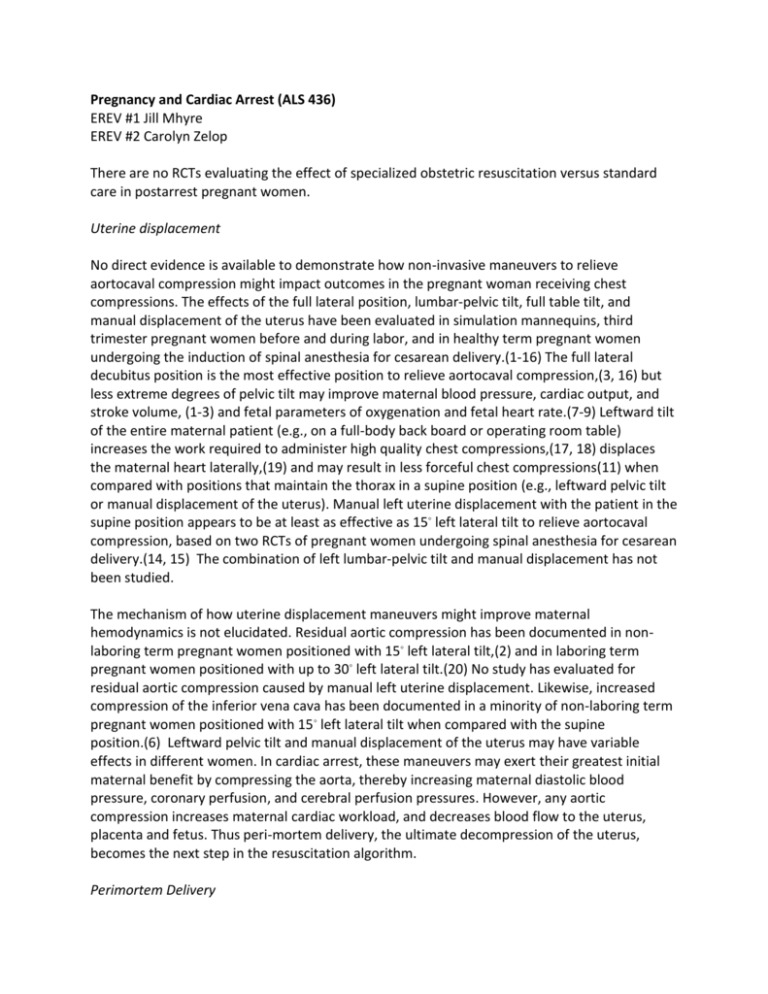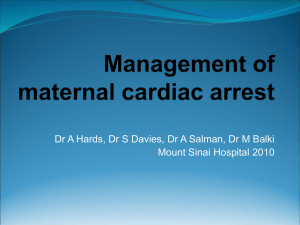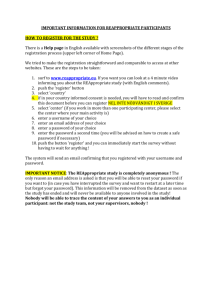ALS 436 Pregnancy text and endnote 1-15-15
advertisement

Pregnancy and Cardiac Arrest (ALS 436) EREV #1 Jill Mhyre EREV #2 Carolyn Zelop There are no RCTs evaluating the effect of specialized obstetric resuscitation versus standard care in postarrest pregnant women. Uterine displacement No direct evidence is available to demonstrate how non-invasive maneuvers to relieve aortocaval compression might impact outcomes in the pregnant woman receiving chest compressions. The effects of the full lateral position, lumbar-pelvic tilt, full table tilt, and manual displacement of the uterus have been evaluated in simulation mannequins, third trimester pregnant women before and during labor, and in healthy term pregnant women undergoing the induction of spinal anesthesia for cesarean delivery.(1-16) The full lateral decubitus position is the most effective position to relieve aortocaval compression,(3, 16) but less extreme degrees of pelvic tilt may improve maternal blood pressure, cardiac output, and stroke volume, (1-3) and fetal parameters of oxygenation and fetal heart rate.(7-9) Leftward tilt of the entire maternal patient (e.g., on a full-body back board or operating room table) increases the work required to administer high quality chest compressions,(17, 18) displaces the maternal heart laterally,(19) and may result in less forceful chest compressions(11) when compared with positions that maintain the thorax in a supine position (e.g., leftward pelvic tilt or manual displacement of the uterus). Manual left uterine displacement with the patient in the supine position appears to be at least as effective as 15◦ left lateral tilt to relieve aortocaval compression, based on two RCTs of pregnant women undergoing spinal anesthesia for cesarean delivery.(14, 15) The combination of left lumbar-pelvic tilt and manual displacement has not been studied. The mechanism of how uterine displacement maneuvers might improve maternal hemodynamics is not elucidated. Residual aortic compression has been documented in nonlaboring term pregnant women positioned with 15◦ left lateral tilt,(2) and in laboring term pregnant women positioned with up to 30◦ left lateral tilt.(20) No study has evaluated for residual aortic compression caused by manual left uterine displacement. Likewise, increased compression of the inferior vena cava has been documented in a minority of non-laboring term pregnant women positioned with 15◦ left lateral tilt when compared with the supine position.(6) Leftward pelvic tilt and manual displacement of the uterus may have variable effects in different women. In cardiac arrest, these maneuvers may exert their greatest initial maternal benefit by compressing the aorta, thereby increasing maternal diastolic blood pressure, coronary perfusion, and cerebral perfusion pressures. However, any aortic compression increases maternal cardiac workload, and decreases blood flow to the uterus, placenta and fetus. Thus peri-mortem delivery, the ultimate decompression of the uterus, becomes the next step in the resuscitation algorithm. Perimortem Delivery Several observational designs have reported data on the effect of perimortem delivery on maternal ROSC, maternal survival to discharge, and neonatal survival among pregnant women. The overall quality of these studies is very low. Most reports of perimortem delivery focus on perimortem cesarean section. Perimortem vaginal delivery may be possible if cardiac arrest transpires at complete cervical dilation and advanced fetal station. As in non-arrested women, the preferred route of delivery depends on obstetric considerations, and all studies that evaluated the impact of perimortem delivery on maternal and neonatal survival were considered together, regardless of the route of delivery. One retrospective cohort study of 55 maternal cardiac arrests evaluated the incidence of perimortem cesarean delivery after the introduction of a training course and compared it with a historical rate generated from an earlier time interval encompassed by the overall study period.(21) Twelve cases of perimortem cesarean delivery between 1998 and 2008 were ascertained by national survey of obstetricians and resuscitation trainers. A control group of pregnant women who experienced cardiac arrest without perimortem delivery was drawn from the Dutch Maternal Mortality Confidential Enquiries (n=35) and from a national study of severe morbidity for the years 2006-2008 (n=8). Due to the differential methods of ascertainment, the data is not appropriate for comparison. Several systematic reviews of case reports of maternal cardiopulmonary resuscitation have been published.(22, 23) In the most recent review, outcomes were more favorable among the reported cases that did not undergo perimortem delivery; publication bias may explain these results. Multivariate analysis of data from 95 case reports demonstrates an association between PMD completed within 10 minutes of cardiac arrest and maternal survival.(23) The time interval between maternal cardiac arrest and delivery was shorter for both maternal survivors compared with non-survivors (107.2 vs minutes) and for neonatal survivors compared with non-survivors (14 vs. minutes).(23) More rapid delivery (<10 minutes) may improve outcomes, but the available data does not allow calculation of a specific point estimate for optimal time interval from maternal cardiac arrest to delivery. A subsequent single-institution case series of 5 cases of maternal CPR describes an experience that is consistent with these findings.(24) Treatment Recommendation There is insufficient evidence to support or refute the use of specific resuscitation techniques for maternal cardiac arrest. However, available evidence suggests that aortocaval decompression and perimortem delivery each may improve maternal and neonatal outcomes in pregnant women with cardiac arrest in the second half of pregnancy. No specific interventions beyond standard resuscitation have been demonstrated to improve outcomes for cardiopulmonary resuscitation during the first half of pregnancy. Knowledge Gaps Research in the area of maternal resuscitation is lacking because cardiac arrest in pregnancy is rare.(25) Most evidence is extrapolated from non-pregnant people, mannequin studies, or case reports. The heterogeneous nature of the etiologies of maternal cardiac arrest, as well as variations in demographics, gestational age and body mass index of the cases all further hamper interpretation of available data. Systematic data collection in pregnant women who have experienced cardiac arrest will require the development of a national or international registry with or without coordinated prospective population-level surveillance. A particular emphasis on cardiovascular etiologies of arrest is warranted given increasing numbers of women with congenital heart conditions having children,(26) the increasing prevalence of cardiomyopathy among pregnant and postpartum women,(26, 27) and the preponderance of cardiovascular disease evident in maternal mortality surveillance reports.(28, 29) References 1. Mendonca C, Griffiths J, Ateleanu B, Collis RE. Hypotension following combined spinal-epidural anaesthesia for Caesarean section. Left lateral position vs. tilted supine position. Anaesthesia. 2003;58(5):428-31. 2. Rees SG, Thurlow JA, Gardner IC, Scrutton MJ, Kinsella SM. Maternal cardiovascular consequences of positioning after spinal anaesthesia for Caesarean section: left 15 degree table tilt vs. left lateral. Anaesthesia. 2002;57(1):15-20. 3. Bamber JH, Dresner M. Aortocaval compression in pregnancy: the effect of changing the degree and direction of lateral tilt on maternal cardiac output. Anesth Analg. 2003;97(1):256-8, table of contents. 4. Calvache JA, Munoz MF, Baron FJ. Hemodynamic effects of a right lumbar-pelvic wedge during spinal anesthesia for cesarean section. Int J Obstet Anesth. 2011;20(4):307-11. 5. Zhou ZQ, Shao Q, Zeng Q, Song J, Yang JJ. Lumbar wedge versus pelvic wedge in preventing hypotension following combined spinal epidural anaesthesia for caesarean delivery. Anaesth Intensive Care. 2008;36(6):835-9. 6. Fields JM, Catallo K, Au AK, Rotte M, Leventhal D, Weiner S, et al. Resuscitation of the pregnant patient: What is the effect of patient positioning on inferior vena cava diameter? Resuscitation. 2013;84(3):304-8. 7. Carbonne B, Benachi A, Leveque ML, Cabrol D, Papiernik E. Maternal position during labor: effects on fetal oxygen saturation measured by pulse oximetry. Obstet Gynecol. 1996;88(5):797-800. 8. Tamas P, Szilagyi A, Jeges S, Vizer M, Csermely T, Ifi Z, et al. Effects of maternal central hemodynamics on fetal heart rate patterns. Acta Obstet Gynecol Scand. 2007;86(6):711-4. 9. Abitbol MM. Supine position in labor and associated fetal heart rate changes. Obstet Gynecol. 1985;65(4):481-6. 10. Goodwin AP, Pearce AJ. The human wedge. A manoeuvre to relieve aortocaval compression during resuscitation in late pregnancy. Anaesthesia. 1992;47(5):433-4. 11. Rees GA, Willis BA. Resuscitation in late pregnancy. Anaesthesia. 1988;43(5):347-9. 12. Ellington C, Katz VL, Watson WJ, Spielman FJ. The effect of lateral tilt on maternal and fetal hemodynamic variables. Obstet Gynecol. 1991;77(2):201-3. 13. Matorras R, Tacuri C, Nieto A, Gutierrez de Teran G, Cortes J. Lack of benefits of left tilt in emergent cesarean sections: a randomized study of cardiotocography, cord acid-base status and other parameters of the mother and the fetus. J Perinat Med. 1998;26(4):284-92. 14. Kundra P, Khanna S, Habeebullah S, Ravishankar M. Manual displacement of the uterus during Caesarean section. Anaesthesia. 2007;62(5):460-5. 15. Amaro A, E. C, M. C, M R, J C. Manual left uterine displacement or modified Craford's edge: a comparative study in spinal anesthesia for cesarean delivery. Brazilian Journal of Anesthesiology International. 1999;49(10):11-4. 16. Archer TL, Suresh P, Shapiro AE. Cardiac output measurement, by means of electrical velocimetry, may be able to determine optimum maternal position during gestation, labour and caesarean delivery, by preventing vena caval compression and maximising cardiac output and placental perfusion pressure. Anaesth Intensive Care. 2011;39(2):308-11. 17. Kinsella SM, Harvey NL. A comparison of the pelvic angle applied using lateral table tilt or a pelvic wedge at elective caesarean section. Anaesthesia. 2012;67(12):1327-31. 18. Kim S, You JS, Lee HS, Lee JH, Park YS, Chung SP, et al. Quality of chest compressions performed by inexperienced rescuers in simulated cardiac arrest associated with pregnancy. Resuscitation. 2013;84(1):98-102. 19. Yun J, Lee B. Spatial Relationship of the Left Ventricle in the Supine Position and the Left Lateral Tilt Position (Implication for Cardiopulmonary Resuscitation in Pregnant Patients). Fire Sci Eng. 2013;27(5):75-9. 20. Kinsella SM, Whitwam JG, Spencer JA. Aortic compression by the uterus: identification with the Finapres digital arterial pressure instrument. Br J Obstet Gynaecol. 1990;97(8):700-5. 21. Dijkman A, Huisman CM, Smit M, Schutte JM, Zwart JJ, van Roosmalen JJ, et al. Cardiac arrest in pregnancy: Increasing use of perimortem caesarean section due to emergency skills training? BJOG. 2010;117(3):282-7. 22. Katz V, Balderston K, DeFreest M. Perimortem cesarean delivery: were our assumptions correct? Am J Obstet Gynecol. 2005;192(6):1916-20; discussion 20-1. 23. Einav S, Kaufman N, Sela HY. Maternal cardiac arrest and perimortem caesarean delivery: evidence or expert-based? Resuscitation. 2012;83(10):1191-200. 24. Baghirzada L, Balki M. Maternal cardiac arrest in a tertiary care centre during 1989-2011: a case series. Can J Anaesth. 2013;60(11):1077-84. 25. Mhyre JM, Tsen LC, Einav S, Kuklina EV, Leffert LR, Bateman BT. Cardiac arrest during hospitalization for delivery in the United States, 1998-2011. Anesthesiology. 2014;120(4):810-8. 26. Kuklina E, Callaghan W. Chronic heart disease and severe obstetric morbidity among hospitalisations for pregnancy in the USA: 1995-2006. Bjog. 2011;118(3):345-52. 27. Grotegut CA, Kuklina EV, Anstrom KJ, Heine RP, Callaghan WM, Myers ER, et al. Factors associated with the change in prevalence of cardiomyopathy at delivery in the period 2000-2009: a population-based prevalence study. Bjog. 2014;121(11):1386-94. 28. Creanga AA, Berg CJ, Syverson C, Seed K, Bruce FC, Callaghan WM. Pregnancy-related mortality in the United States, 2006-2010. Obstet Gynecol. 2015;125(1):5-12. 29. Knight M, Kenyon S, Brocklehurst P, Neilson J, Shakespeare J, Kurinczuk J, et al. Saving Lives, Improving Mothers Care - Lessons learned to inform future maternity care from the UK and Ireland Confidential Enquiries into Maternal Deaths and Morbidity 2009-2012. Oxford, United Kingdom: National Perinatal Epidemiology Unit, University of Oxford; 2014.








